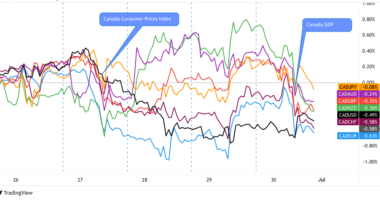It was another positive week for the U.S. dollar, which found support from speculations that the Fed will keep its interest rates higher for longer.
But the same hawkish sentiments didn’t do the other major currencies favors, as weak data releases also sparked concerns that a high interest rate would negatively affect their respective economies’ growth trajectories.
In commodities, the non-yielding gold saw an intraweek downtrend while supply-related news bumped up the major crude oil benchmarks.
So, how exactly did the major global assets behave this week? I can explain, but lemme show you the biggest headlines first:
Notable News & Economic Updates:
🟢 Broad Market Risk-on Arguments
- On Tuesday, Chinese property developer Country Garden Holdings managed to avoid default by paying $22.5 million in coupons but still seeking to extend payments on seven more onshore bonds by three years
- S&P Global ASEAN Manufacturing PMI in August: 51.0 vs. 50.8; “The rate of input price inflation accelerated for the first time in seven months.”
- Bank of England Governor Bailey said on Wednesday to lawmakers that they are no longer in a phase where it was clear that rates needed to rise and that policy is restrictive.
- Australian GDP grew 0.4% q/q in Q2 2023 vs. estimated 0.3% expansion, previous quarter growth upgraded to 0.4% from initially reported 0.2% uptick
- The Bank of Canada today held its target for the overnight rate and deposit rate at 5.00% on Wednesday as expected; Sees evidence of excess demand easing, but is prepared to increase policy interest rate further if needed
- Canada Employment Change for August 2023: 39.9K (-8.0K forecast; -6.4K previous); Unemployment Rate was 5.5% (5.7% forecast); Average Hourly Wages: 5.2% y/y (4.8% y/y forecast)
🔴 Broad Market Risk-off Arguments
- Reserve Bank of Australia kept interest rates on hold at 4.10%, citing that “further tightening may be needed” but that inflation may have already passed its peak and that uncertainties are weighing on the outlook
- Swiss GDP showed that economic activity was flat in Q2 vs. estimated 0.1% q/q growth figure and earlier 0.3% expansion
- Saudi Arabia and Russia extends the 1.3M barrel/day cut through December
- Chinese Caixin services PMI fell from 54.1 in July to 51.8 in August vs. estimated 53.6 figure, reflecting the slowest pace of growth in eight months
- The latest ECB Consumer Expectation Survey showed rising inflation expectations
- Chinese trade surplus fell from $80.6 billion to $68.4 billion in August, as imports and exports both declined again
- S&P Global US Services PMI for August: 50.5 vs. 52.3 in July; businesses are starting to see waning post-pandemic economic strength; sees renewed “upward pressure on energy, fuel & transportation costs”
- German factory orders tumbled 11.4% m/m in July vs. expected 4.3% decrease and previous 7.6% gain (upgraded from initially reported 7.0% figure)
- In a speech in Calgary, Alberta, BOC Gov. Macklem said that, aside from the delayed impact of higher interest rates, one possible reason for inflation staying above target is that “monetary policy is not yet restrictive enough.”
- Fed Speak lifts Dollar: Cleveland Fed President Loretta Mester said on Tuesday that interest rates may need to be “a bit higher,” but said that there’s plenty of time until the next meeting to weigh upcoming data
- German industrial production slumped by 0.8% m/m in July vs. estimated 0.4% dip and earlier 1.5% decline
- Japan’s final GDP revised lower from 6.0%y/y to 4.8% y/y in Q2 due to weak capital spending; cash earnings was up by 1.3% y/y in July (vs. 2.4% expected, 2.3% previous) but real wages fell by 2.5% y/y
Global Market Weekly Recap
The week started pretty chill enough, with Asian and European session traders taking cues from Friday’s weak U.S. jobs report and the possibility of the Fed not tightening its policies further.
Risk takers also found support from news that China’s property giant Country Garden got an approval to extend its payments from an onshore private bond. It also didn’t hurt that the U.S. and Canadian markets were out on bank holidays and there were no new catalysts to kill the risk-friendly vibe.
Easing contagion risks in China’s construction industry mixed with less hawkish Fed expectations to push Asian equities (and AUD and NZD) higher during the Asian session and the European equities (and EUR and GBP) up during the London session.
And then the Fire Nation attacked. And by Fire Nation I mean weak economic data.
For starters, China’s Caixin services PMI printed its weakest reading in 8 months in August.
Meanwhile, the Reserve Bank of Australia (RBA) kept its interest rates steady at 4.10% as expected. It also mentioned that “inflation has passed its peak” though “some further tightening” may still be needed.
In Europe, the Eurozone PMIs showed private sector activity contracting by the most in nearly three years. Not good when core CPI data released last week already point to the European Central Bank (ECB) maintaining its rates in September.
The weak PMI reports and the possibility of less hawkish ECB and RBA highlighted the Fed’s biases and helped push U.S. 10-year Treasury yields and the U.S. dollar higher. Some also speculate that companies dumped their bonds ahead of this month’s major U.S. reports and Fed decision, but the info is sus at best.
In any case, USD was king of pips that day and currencies like AUD, NZD, CAD, EUR, and GBP took hits. USD/JPY even hit 147.80 before the buyers calmed down! U.S. Treasury yields also spiked to 4.275% and barely saw pullbacks.
The only “risky” asset that didn’t drop was crude oil, which found support from Saudi Arabia and Russia extending its voluntary cut of 1 million barrels of oil per day for another three months to December and Russia extending its own export reduction by 300,000 bpd until the year’s end.
USOIL was trading near its $85.00 weekly lows before it jumped all the way to $88.00 during the U.S. session.
Wednesday saw some relief from all the selling. Comdolls like AUD and NZD, for example, were boosted by a better-than-expected Australian GDP and talks of China’s state-owned banks selling USD/CNY to support the yuan.
The spotlight then turned to Bank of England (BOE) Governor Bailey when he said that the central bank is “much nearer to the top of the [rate hike] cycle” and that we may see a “marked” drop in inflation by the end of the year.GBP dropped across the board and ended the trading day near new intraday lows. Yikes!
We did see a return to the pro-USD, anti-risk theme during the U.S. session when a strong U.S. ISM services PMI supported a higher-for-longer policy plan for the Fed. This also correlates with falls in gold, crypto and equities.
It didn’t help risk-takers that Apple shares lost about 1% of its market cap on reports that China had orders central government agencies to not use iPhones and other foreign-branded devices for work. Oh, and the European Commission also designated Amazon, Apple, Alphabet, Meta, Microsoft and China’s ByteDance as “gatekeepers” under its new Digital Markets Act.
The non-yielding gold dropped to its intraweek low near $1,915 while the U.S. equities accelerated its weekly downtrend with a sharp downswing.
Meanwhile, the Canadian dollar barely reacted to the Bank of Canada (BOC) maintaining its interest rates (and its openness to further rate hikes) as the markets had expected.
Thursday trading saw appears to have leaned risk-off, most notably around when China printed off weak trade data (another signal of growing economic weakness). Without other major catalysts to be seen, bond yields, oil prices, equity futures and crypto too a turn lower around that release during the Asia session.
Focus shifted during the U.S. session, though, when the U.S. initial jobless claims numbers show continued strength in the U.S. employment sector. Traders apparently weighed this as a signal of lower recession odds more than an argument for the Fed to raise interest rates, evidenced by the initial rebound in risk assets like equities and crypto.
On Friday, volatility appeared limited with the lack of major news during most of the Asia and London session. The big mover of note came later during the U.S. session, when the Canadian dollar spiked higher after a surprise positive jobs read from Canada.
It was strong numbers all around, including a much stronger-than-expected average hourly earnings read, which the Bank of Canada is watching closely as a contributor to future interest rate decisions. The strong read obviously supports the idea that the BOC can’t ease up in their inflation fight just yet, and why the Loonie spiked higher to solidify its spot just behind the Greenback among the major currencies at the week close.










